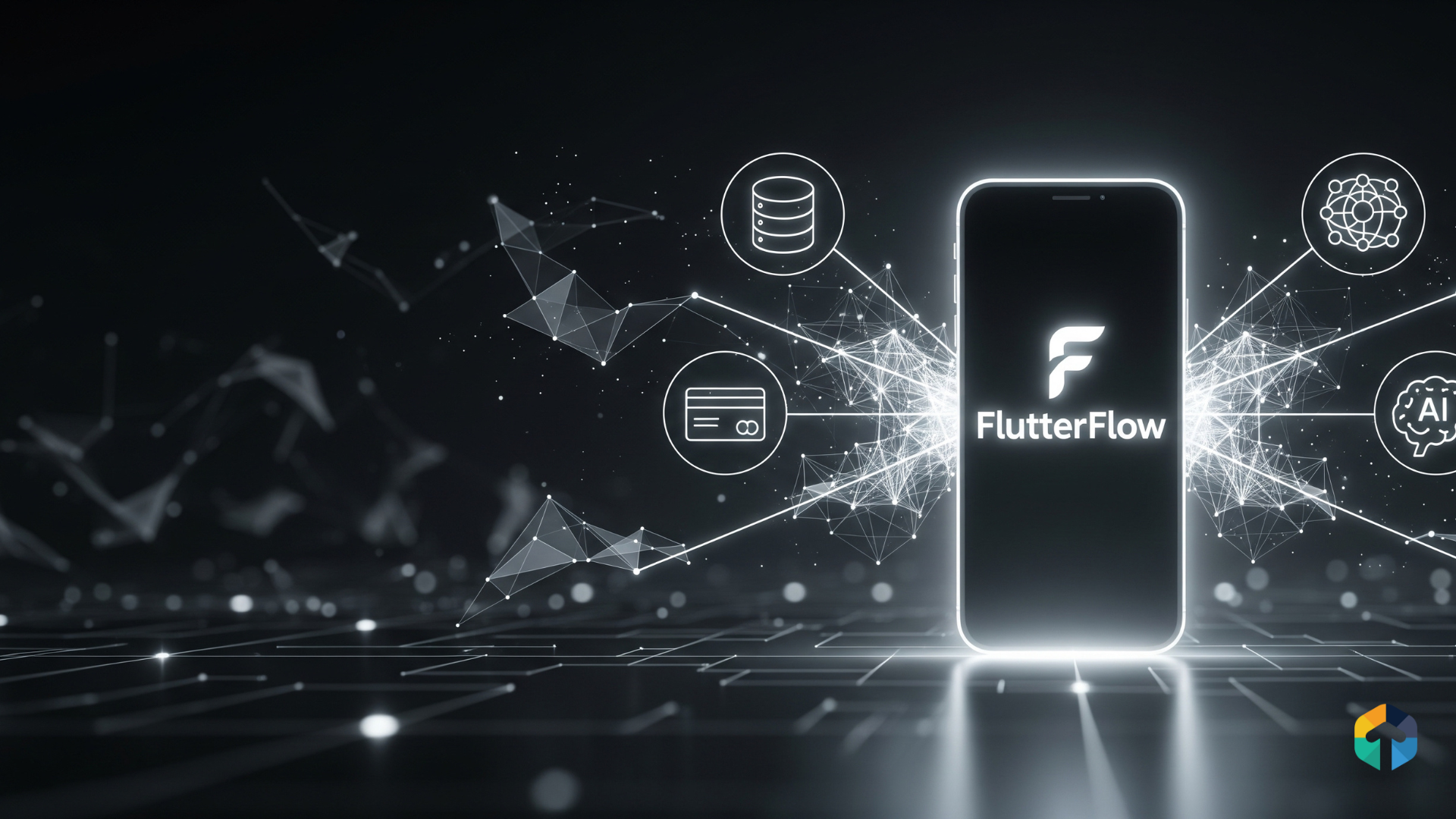
According to a report by the Business Research Company, the app integration market will soar to new heights, increasing at a CAGR of 21.1% to $23.53 billion by the end of this year. There is a definite reason for this upsurge in demand for no-code integrations and API integration solutions.
App integrations have a vital role to play in improving the functioning of the apps built on low-code platforms. FlutterFlow integration does that by impeccably sharing data and triggering actions across multiple platforms. The end result is that your users get a more streamlined UX, improved efficiency, and better overall business functionalities by removing data silos through mobile app integrations. It also allows friction-free workflows between different systems.
If you are looking to develop apps without extensive coding knowledge, count on the FlutterFlow development platform to win brownie points. This no-code/low-code app development platform's biggest plus point is its ability to improve your app's functionality with FlutterFlow integrations with zero effort.
Now, you might wonder - what FlutterFlow integrations are available? In a few seconds, you will have the answer to this question. We also promise you that by the time you end this incredible expedition of FlutterFlow API integrations, you will understand the role of the FlutterFlow platform in making your applications more valuable and efficient through no-code integrations.
Types of Integrations Available in FlutterFlow
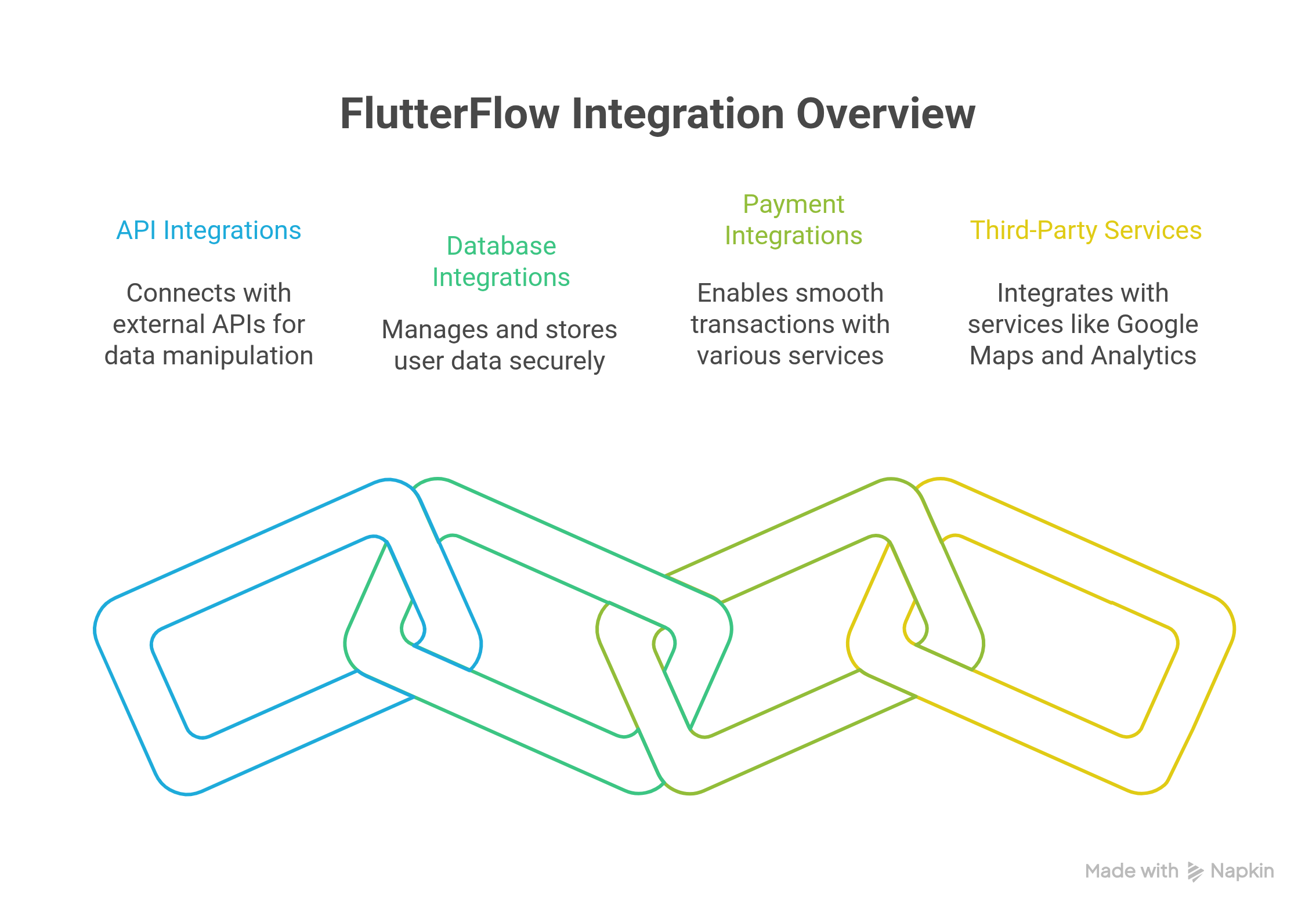
When you deep dive into the FlutterFlow integrations, you will find that there are varied types of no-code integrations that can magnify the effects of your Flutter app development using the low-code platform. However, for your reference, we have bifurcated these app integrations into different kinds that will make your job easier to get a brief overview of the various types of FlutterFlow API integrations.
These include API integrations, which help your FlutterFlow apps connect with external APIs, allowing you to retrieve and manipulate data from various services through FlutterFlow API calls, including AI tools like OpenAI and Gemini.
Next comes the database FlutterFlow database integrations, which help your no-code app development establish connections with different database solutions, such as FlutterFlow Firebase, FlutterFlow Supabase, and SQLite. These mobile app integrations help manage and store user data with utmost precision and security.
The next is FlutterFlow payment integration, which allows users to perform smooth transactions using Stripe, RazorPay, and RevenueCat to ensure they get the best experience while operating your no-code integrations-powered app.
The final ones on the list are the third-party services that integrate your FlutterFlow development app using the low-code platform, such as Google Map, Mapbox, OneSignal, Mux Livestream, Google Analytics, and AdMob through FlutterFlow API connections.
1. APIs
- Gemini FlutterFlow API
- OpenAI integrations
2. Database
- FlutterFlow Firebase
- FlutterFlow Supabase
- SQLite FlutterFlow database integrations
3. Payment
- Stripe FlutterFlow payment integration
- Razorpay mobile app integrations
- RevenueCat no-code integration
4. Third-Party Services
- Google Map FlutterFlow integrations
- Mapbox API integration
- OneSignal third-party integrations
- MuxLiveStream FlutterFlow API
- Google Analytics app integrations
- AdMob no-code integrations
Now that you have a basic understanding of the different types of FlutterFlow integrations, it is time to look at some of the powerful no-code integrations that can make your Flutter app development more effective and productive.
Popular FlutterFlow Integrations
FlutterFlow integrations help provide another dimension to Flutter app development by connecting them with built-in features to the extensive world of third-party integrations and FlutterFlow API services.

Here are some popular no-code integrations you must try in the low-code platform.
1. Firebase: The Ultimate FlutterFlow Database Integration
If you wish to develop ultra-modern apps using the functionality of the FlutterFlow platform, look no further than the FlutterFlow Firebase integration. This powerful FlutterFlow database integration helps you get different functionalities in your no-code app development projects, like user authentication, analytics, real-time database, and crash reporting.
FlutterFlow Firebase backend services help make your mobile app integrations look 100% better through seamless API integration. The biggest advantage is that setting up FlutterFlow Firebase does not take much time in this low-code platform, which gives your Flutter app development a definite edge over traditional coding approaches.
2. Supabase: Powerful Real-Time Database Integration
When you integrate FlutterFlow Supabase into your FlutterFlow projects, developers gain access to a potent real-time database solution that makes it hassle-free to develop apps that allow people to collaborate and communicate with one another.
The biggest plus of FlutterFlow Supabase is that it allows developers to manage their data in real-time through FlutterFlow API connections. This means that if a developer makes changes in the mobile app integrations, they are instantly reflected in other developers connected to different devices through this low-code platform.
3. AWS: Enterprise-Grade Third-Party Integrations
Integrating AWS into FlutterFlow development projects gives you access to different AWS services through FlutterFlow API connections, including Cognito for user authentication, DynamoDB for NoSQL management, S3 for storage, Lambda for serverless functions, and API gateway for managing API integration endpoints.
All these features are accessible through FlutterFlow API calls within this ingenious no-code integrations platform, allowing you to develop strong mobile app integration features without requiring much coding experience in your Flutter app development.
4. Stripe: Secure Payment Integration Solution
If you are looking for a secure and efficient FlutterFlow payment integration for your FlutterFlow development apps, the Stripe third-party integration is ideal for your development needs. It allows you to configure one-time payments, subscriptions, or in-app purchases easily through no-code integrations.
Count on Stripe FlutterFlow payment integration to be your dependable gateway partner and help your mobile app integrations users have an impeccable transaction experience at all times.
5. Algolia: Advanced Search API Integration
When you wish to include search functionality in your FlutterFlow development app, count on Algolia API integration to develop lightning-fast speed and relevant algorithms through FlutterFlow API connections to provide a seamless experience to your users. With Algolia no-code integrations, your users can get what they want on your app with minimal effort.
It can be used to search for content on web and mobile app integration platforms. This FlutterFlow integrations solution is ideal for content-heavy, eCommerce, social networking, and directory apps built on the low-code platform.
6. Google Analytics: App Performance Tracking
Integrating Google Analytics into your FlutterFlow development projects helps you get pertinent data concerning how users behave on your Flutter app development and their engagement level through FlutterFlow API connections. With this information from third-party integrations, you can make the wise call to improve the app and enhance the user experience.
Look for key information like how users interact with your no-code integrations-powered app, the time they stay, and the number of users who convert. These powerful FlutterFlow integrations can log custom events and record additional information you wish to collect for a specific event through API integration.
7. Google Maps: Location-Based Mobile App Integrations
Google Maps FlutterFlow integrations into development projects allow you to integrate location-based features into your Flutter app development apps effortlessly through FlutterFlow API connections.
You can display a randomly selected location or set a specific area based on longitude and latitude values in your mobile app integrations. It is even possible to track a user's current location, change the map type, and add markers through this low-code platform.
8. AdMob: Monetization Through No-Code Integrations
This powerful FlutterFlow integration allows you to make money by seamlessly including ads in your apps built on this ingenious no-code app development platform. This is an uncomplicated way to monetize your Flutter app development by showcasing targeted ads to users while ensuring that your users get a superlative experience through mobile app integrations.
The biggest plus of AdMob third-party integrations with the FlutterFlow development platform is that it gives you an edge in custom-building ad placements, using a wide array of ad formats, including rewarded videos, and even effectively managing ad revenue by gaining access to the AdMob dashboard through the FlutterFlow API.
9. Mux Livestream: Video Streaming Integration
This widely used FlutterFlow integration has gained much popularity in recent years for mobile app integrations. The most significant advantage of including these third-party integrations in your FlutterFlow development projects is their ability to incorporate live video capabilities in the app on this ingenious low-code platform.
Thus, it helps you with seamless streamlining, swift Flutter app development, strong streaming features, and easy-to-use execution so that live content can get quickly reflected on your no-code integrations powered FlutterFlow apps through API integration.
10. SQLite: Local Database Integration
This effective FlutterFlow database integration allows you to use SQLite as your local database in no-code app development. It helps you take advantage of hassle-free implementation, cross-platform compatibility, and offline data storage through FlutterFlow API connections.
It also does not require setting up a distinct server to manage the mobile app integrations database effectively. You can use these FlutterFlow integrations when your apps need quick local data access and desperately need offline functionality in your Flutter app development.
11. OneSignal: Push Notification Integration
If you wish to incorporate push notifications in your FlutterFlow development apps, you can send targeted messages to your users through third-party integrations. These no-code integrations help improve their engagement and retention by sending timely updates and personalized alerts.
The intuitive visual development interface of the low-code platform makes all this possible through the FlutterFlow API, resulting in swift execution.
12. Gemini: AI-Powered Cryptocurrency Integration
Integrating Gemini, a state-of-the-art AI model, with FlutterFlow development projects is a natural inclination when dealing with mobile app integrations. It enables immaculate and safe cryptocurrency transactions within the app through FlutterFlow API connections. This way, your no-code integrations users get the best experience when you automate complex processes and provide concurrent insights through API integration.
As you have now looked at the popular FlutterFlow integrations, the time is right to learn how to integrate the FlutterFlow API in the low-code platform - our next section.
How to Integrate APIs in FlutterFlow?
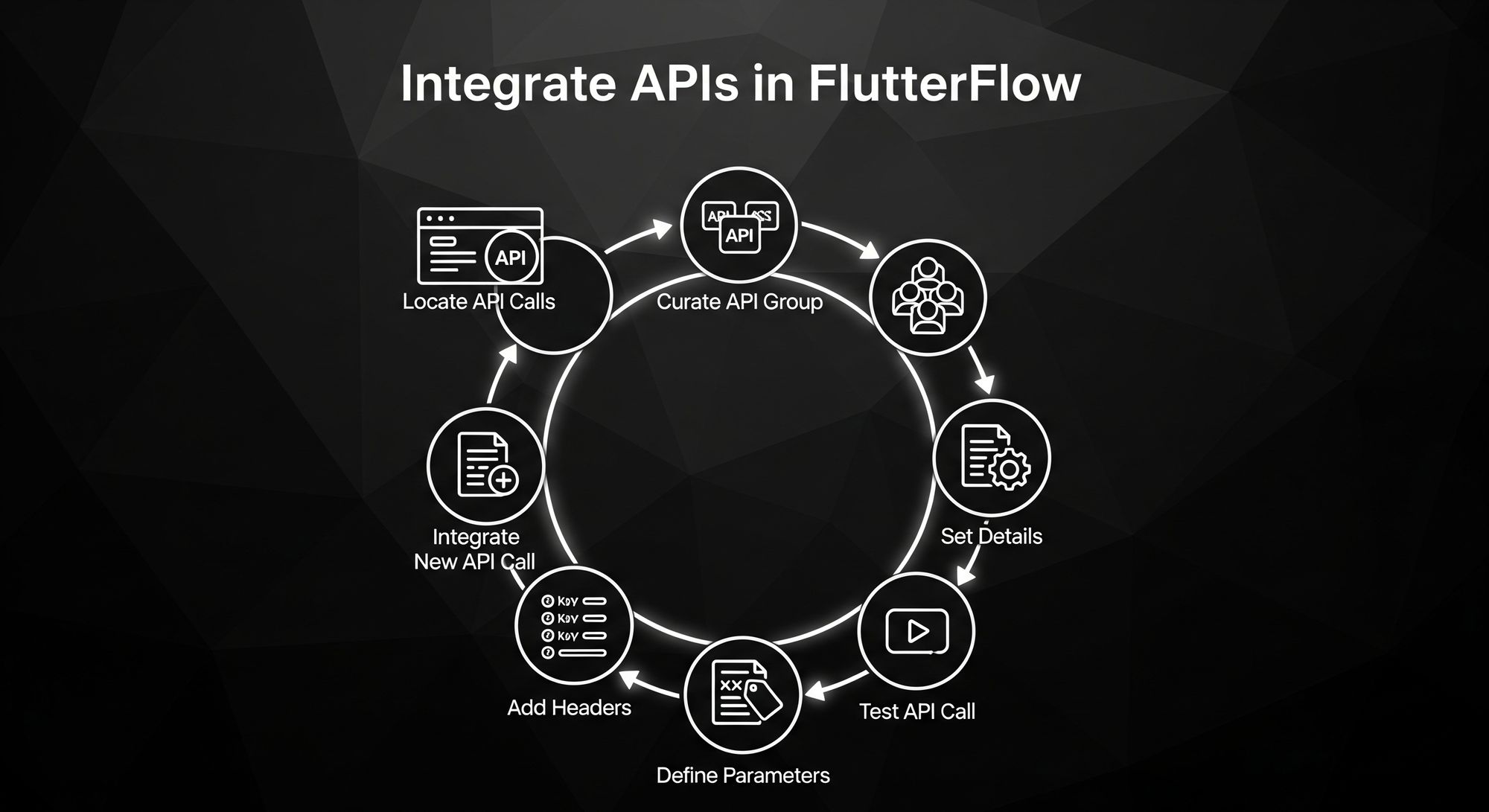
Here are some steps that will help you integrate APIs in FlutterFlow.
1. Locate the API Calls Section
Opt for the “API Calls” section, which can be found on the left-hand navigation menu.
2. Curate a Fresh API Group
This is an optional step. If you have a large number of APIs with look-alike URLs or headers, it is recommended that you curate an API group to group them.
3. Integrate a Brand-New API Call
Hit the “Add” button and opt for “Create API Call.”
4. Set Details (Name, Method Type, and API URL)
Next, you will be asked to provide details like the descriptive name of the API and HTTP method type. Here, you choose from options like GET, PUT, DELETE, POST, etc.). Then, you will have to insert the API's endpoint URL.
5. Add Headers(If Required)
This is where you need to insert any required headers, including content type or authorization tokens.
6. Define the Parameters (If Required)
Mention any query parameters or body type that your API needs.
7. Test Your API Call
This is the final step, where you can use the FlutterFlow platform's built-in features to ensure that your API call functions correctly.
Best Ways to Use API Calls in Your FlutterFlow App
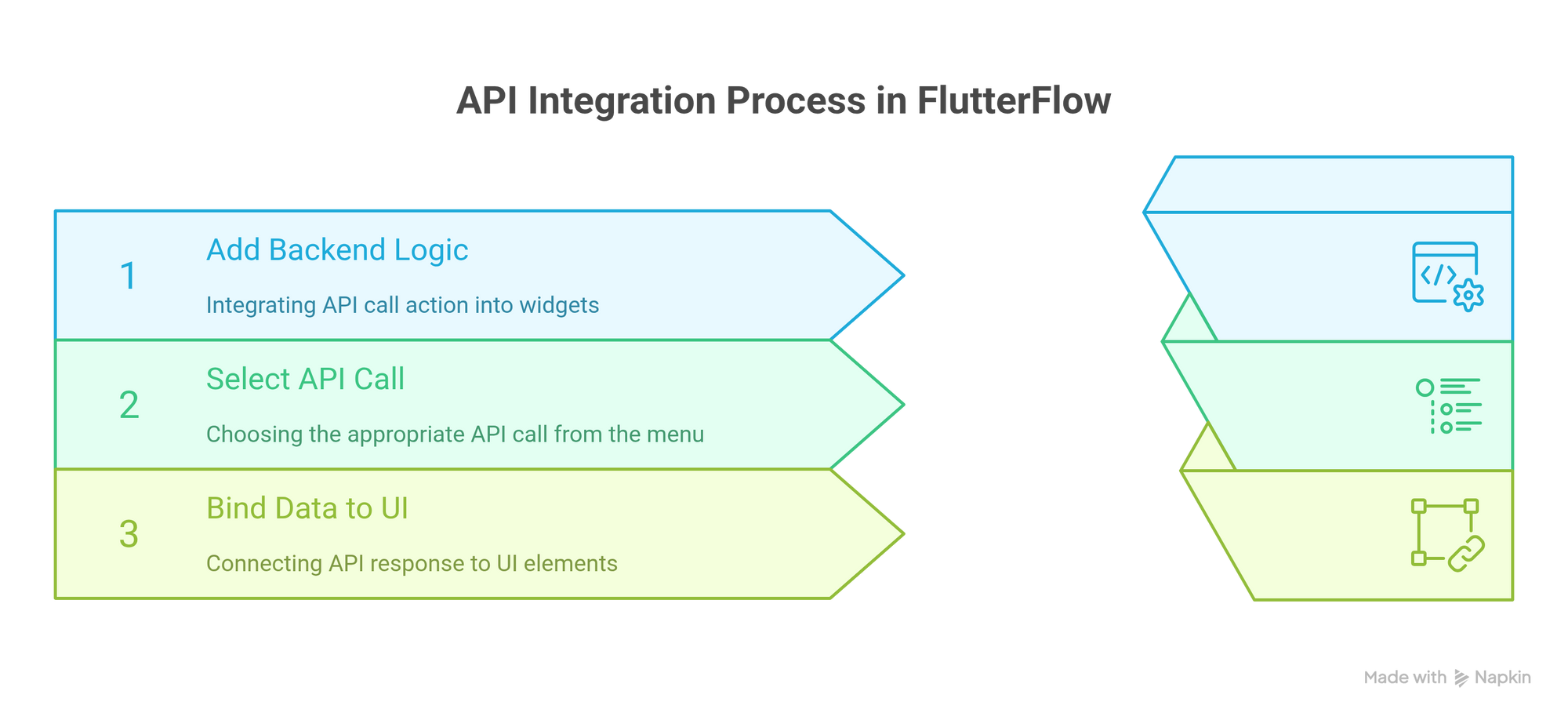
1. Add Backend Logic
Whenever you wish to fetch data from an API within your app, integrate the “Backend Logic” action into a widget. Next, select the appropriate API call from the drop-down menu.
2. Practice Data Binding
This is where you bind the response from the API call to UI elements, including lists or widgets to depict the recovered data on the screen.
Best Practices for FlutterFlow Integrations

Here are some best practices for incorporating FlutterFlow integrations into your applications.
1. Always Keep Firebase as Your Primary Backend
The seamless integration of the FlutterFlow platform with the Firebase backend ensures that your apps get proper user authentication, real-time updates, and data storage when you make Firebase your primary backend.
2. Opt for Responsive Design
It is recommended that apps be developed using the FlutterFlow platform's responsive design features to look alluring regardless of the screen size and device used.
3. Create Reusable Components
Reusable components are a blessing in disguise that can simplify your FlutterFlow project's organization and maintain the same consistency in simple code management.
4. Opt for a Version Control System
You should utilize a version control system like Git to track all your changes, collaborate with fellow developers efficiently, and revert to previous versions without fuss.
5. Employ Effective Data Handling Techniques
Execute effective data handling methodologies to avoid performance problems, mainly when dealing with large datasets.
6. Follow Stringent Security Measures
Make sure that you have secure API integration, proper authorization rules, and data encryption so that your sensitive data always remains protected.
7. Conduct All-Inclusive Testing
You must perform well-rounded testing that includes all the devices and scenarios to ascertain potential bottlenecks early and ensure that your users enjoy operating the application.
Third Rock Techkno Expertise in FlutterFlow Integrations
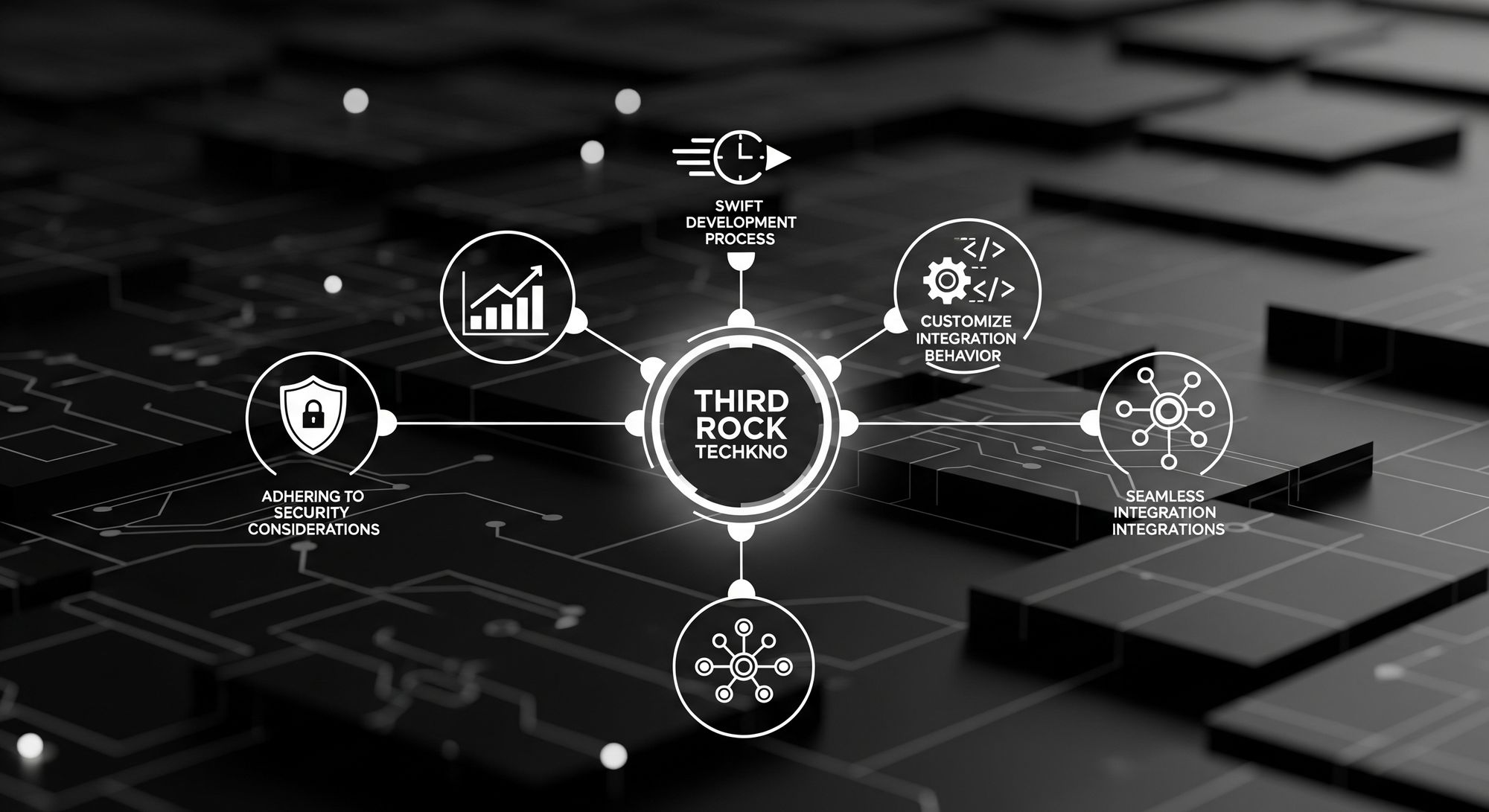
1. Swift Development Process
Our FlutterFlow developer team has the requisite experience and knack for developing complex apps by optimally leveraging pre-built integrations and accessible services.
2. Highly Scalable Integration Solutions
We help startups and established businesses scale their applications by adding brand-new integrations per their business requirements.
3. Customize Integration Behavior Using Custom Code, if Required
We develop custom integration solutions that serve the exclusive needs of our esteemed clientele, where pre-built integrations are virtually impossible.
4. Adhering to Security Considerations
We execute best security practices to ensure secure API integration, authentication, and data handling so that your sensitive data remains secure within our FlutterFlow apps.
5. Seamless Integrations with API, Database, and Third-Party Integrations
We have gained prowess in seamlessly integrating FlutterFlow apps with external APIs to retrieve and manipulate data from different services, including social media platforms, weather APIs, CRM systems, etc.
Our developers also connect FlutterFlow apps with other database solutions like Firebase, Supabase, or custom databases to ensure proper storage and management of data. We can also curate custom integration solutions that meet the exclusive needs of your business using third-party integrations.
Power pack Your App with Effective FlutterFlow Integrations.
When you use FlutterFlow app integrations, you can quickly integrate complex features into the apps by immaculately establishing connections with different third-party services. This comprises mapping APIs, authentication providers, and payment gateways.
The good part is that all of this is achieved without needing to develop the backend structure from scratch. This way, the development cost gets curtailed, and you end up with a seamless app development process.
If you are looking for FlutterFlow app development, we can help you build an application in no time. With decade of experience and offical FlutterFlow partner we have the expertises to turnyour vision a reality. Contact us today!
FAQs
1. Is it possible to deploy a private API in FlutterFlow??
Absolutely! To ensure your API call is private, go to the Advanced Settings tab and turn on the Make Private toggle. Next, click save and then deploy APIs. Alternatively, by making this API call, you can compel a user to authenticate with the help of Firebase authentication. To do so, you must turn on the Require Authentication option.
2. What is the process to store API responses in FlutterFlow?
The first thing you need to do is curate custom data that matches your JSON structure. You can do this by opening your API call definition > Response & Test tab > Response Type > enabling Parse as Data Type. Opt for the data type you wish to convert into.
3. What is the process to integrate Gemini with FlutterFlow?
First, go to Settings and Integrations > Integration > Gemini. Now, click “Enable Gemini” and paste the copied API key into the designated field. This will allow you to integrate Gemini actions at the desired time in your application.
4. Is it possible to customize the integration behavior?
Although the majority of the integrations are managed visually, you can get the option to write custom code to customize the integration according to your individual needs. You can use the features and functionalities depending on the integration you opt for.
5. What are the advantages of using FlutterFlow integrations?
Thanks to the platform’s low-code/no-code approach, users with limited coding experience can quickly develop the app using different services like Firebase authentication, Stripe payments, Google Maps, etc. You can integrate features that can work seamlessly across iOS and Android platforms.

